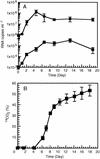Rhodanobacter sp. strain BPC1 in a benzo[a]pyrene-mineralizing bacterial consortium
- PMID: 12450801
- PMCID: PMC134403
- DOI: 10.1128/AEM.68.12.5826-5833.2002
Rhodanobacter sp. strain BPC1 in a benzo[a]pyrene-mineralizing bacterial consortium
Abstract
A bacterial consortium which rapidly mineralizes benzo[a]pyrene when it is grown on a high-boiling-point diesel fuel distillate (HBD) was recovered from soil and maintained for approximately 3 years. Previous studies have shown that mobilization of benzo[a]pyrene into the supernatant liquid precedes mineralization of this compound (R. Kanaly, R. Bartha, K. Watanabe, and S. Harayama, Appl. Environ. Microbiol. 66:4205-4211, 2000). In the present study, we found that sterilized supernatant liquid filtrate (SSLF) obtained from the growing consortium stimulated mineralization of benzo[a]pyrene when it was readministered to a consortium inoculum without HBD. Following this observation, eight bacterial strains were isolated from the consortium, and SSLF of each of them was assayed for the ability to stimulate benzo[a]pyrene mineralization by the original consortium. The SSLF obtained from one strain, designated BPC1, most vigorously stimulated benzo[a]pyrene mineralization by the original consortium; its effect was more than twofold greater than the effect of the SSLF obtained from the original consortium. A 16S rRNA gene sequence analysis and biochemical tests identified strain BPC1 as a member of the genus Rhodanobacter, whose type strain, Rhodanobacter lindaniclasticus RP5557, which was isolated for its ability to grow on the pesticide lindane, is not extant. Strain BPC1 could not grow on lindane, benzo[a]pyrene, simple hydrocarbons, and HBD in pure culture. In contrast, a competitive PCR assay indicated that strain BPC1 grew in the consortium fed only HBD and benzo[a]pyrene. This growth of BPC1 was concomitant with growth of the total bacterial consortium and preceded the initiation of benzo[a]pyrene mineralization. These results suggest that strain BPC1 has a specialized niche in the benzo[a]pyrene-mineralizing consortium; namely, it grows on metabolites produced by fellow members and contributes to benzo[a]pyrene mineralization by increasing the bioavailability of this compound.
Figures





Similar articles
-
Multiple mechanisms contribute to the biodegradation of benzo[a]pyrene by petroleum-derived multicomponent nonaqueous-phase liquids.Environ Toxicol Chem. 2004 Apr;23(4):850-6. doi: 10.1897/03-191. Environ Toxicol Chem. 2004. PMID: 15095879
-
Rapid mineralization of benzo[a]pyrene by a microbial consortium growing on diesel fuel.Appl Environ Microbiol. 2000 Oct;66(10):4205-11. doi: 10.1128/AEM.66.10.4205-4211.2000. Appl Environ Microbiol. 2000. PMID: 11010861 Free PMC article.
-
Degradation and mineralization of high-molecular-weight polycyclic aromatic hydrocarbons by defined fungal-bacterial cocultures.Appl Environ Microbiol. 2000 Mar;66(3):1007-19. doi: 10.1128/AEM.66.3.1007-1019.2000. Appl Environ Microbiol. 2000. PMID: 10698765 Free PMC article.
-
Bioremediation and microbial metabolism of benzo(a)pyrene.Mol Microbiol. 2018 Aug;109(4):433-444. doi: 10.1111/mmi.14062. Epub 2018 Aug 3. Mol Microbiol. 2018. PMID: 29995976 Review.
-
Current Status of and Future Perspectives in Bacterial Degradation of Benzo[a]pyrene.Int J Environ Res Public Health. 2020 Dec 31;18(1):262. doi: 10.3390/ijerph18010262. Int J Environ Res Public Health. 2020. PMID: 33396411 Free PMC article. Review.
Cited by
-
Marine crude-oil biodegradation: a central role for interspecies interactions.Aquat Biosyst. 2012 May 16;8(1):10. doi: 10.1186/2046-9063-8-10. Aquat Biosyst. 2012. PMID: 22591596 Free PMC article.
-
Effect of physical sediments reworking on hydrocarbon degradation and bacterial community structure in marine coastal sediments.Environ Sci Pollut Res Int. 2015 Oct;22(20):15248-59. doi: 10.1007/s11356-015-4373-2. Epub 2015 Apr 7. Environ Sci Pollut Res Int. 2015. PMID: 25847440
-
Succession Patterns of Microbial Composition and Activity following the Diesel Spill in an Urban River.Microorganisms. 2023 Mar 8;11(3):698. doi: 10.3390/microorganisms11030698. Microorganisms. 2023. PMID: 36985271 Free PMC article.
-
Concentrations and origin of polychlorinated biphenyls (PCBs) and polycyclic aromatic hydrocarbons (PAHs) in sediments of western Spitsbergen fjords (Kongsfjorden, Hornsund, and Adventfjorden).Environ Monit Assess. 2017 Apr;189(4):175. doi: 10.1007/s10661-017-5858-x. Epub 2017 Mar 21. Environ Monit Assess. 2017. PMID: 28324278
-
Multispecies Diesel Fuel Biodegradation and Niche Formation Are Ignited by Pioneer Hydrocarbon-Utilizing Proteobacteria in a Soil Bacterial Consortium.Appl Environ Microbiol. 2020 Dec 17;87(1):e02268-20. doi: 10.1128/AEM.02268-20. Print 2020 Dec 17. Appl Environ Microbiol. 2020. PMID: 33067200 Free PMC article.
References
-
- Aitken, M. D., W. T. Stringfellow, R. D. Nagel, C. Kazunga, and S.-H. Chen. 1998. Characteristics of phenanthrene-degrading bacteria isolated from soils contaminated with polycyclic aromatic hydrocarbons. Can. J. Microbiol. 44:743-752. - PubMed
-
- Altschul, S. F., W. Gish, W. Miller, E. W. Myers, and D. J. Lipman. 1990. Basic local alignment search tool. J. Mol. Biol. 215:403-410. - PubMed
-
- Angerer, J., C. Mannschreck, and J. Gündel. 1997. Biological monitoring and biochemical effect monitoring of exposure to polycyclic aromatic hydrocarbons. Int. Arch. Occup. Environ. Health 70:365-377. - PubMed
-
- Atlas, R. M. 1993. Handbook of microbiological media. CRC Press, Inc., Boca Raton, Fla.
Publication types
MeSH terms
Substances
LinkOut - more resources
Full Text Sources
Molecular Biology Databases

